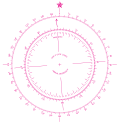Compass rose
A compass rose is a drawing on a map that shows the cardinal directions.
| Wind | Greek | Romant | Frankish |
|---|---|---|---|
| N | Aparctias (ὰπαρκτίας) | Septentrio | Nordroni |
| NNE | Meses (μέσης) or Boreas (βoρέας) |
Aquilo | Nordostroni |
| NE | Caicias (καικίας) | Caecias | Ostnordroni |
| E | Apeliotes (ὰπηλιώτης) | Subsolanus | Ostroni |
| SE | Eurus (εΰρος) | Vulturnus | Ostsundroni |
| SSE | Euronotus (εὺρόνοtος) | Euronotus | Sundostroni |
| S | Notos (νόtος) | Auster | Sundroni |
| SSW | Libonotos (λιβόνοtος) | Libonotus or Austroafricus |
Sundvuestroni |
| SW | Lips (λίψ) | Africus | Vuestsundroni |
| W | Zephyrus (ζέφυρος) | Favonius | Vuestroni |
| NW | Argestes (ὰργέστης) | Corus | Vuestnordroni |
| NNW | Thrascias (θρασκίας) | Thrascias or Circius | Nordvuestroni |
In other media
- Ursula K. Le Guin, The Compass Rose, collection of short stories, 1982 ISBN 0-06-014988-4
- "La Rosa de los Vientos", Spanish film written and directed by Patricio Guzman, 1983
Compass Rose Media
A common compass rose as found on a nautical chart showing both true north (using a nautical star symbol) and magnetic north with magnetic variation. Also notice the correspondence between the 32-point rose (inner circle) and the modern 0–360° graduations.
Compass rose with the eight principal winds.
A 16-point compass rose on the grounds of a library serves both as a pedagogical device and public art.
First ornate compass rose depicted on a chart, from the Catalan Atlas (1375), with the Pole Star as north mark
More ornate compass rose, with letters of traditional winds, a cross pattée (referring to Jerusalem) for east, and a compass needle as north mark, from a nautical chart by Jorge de Aguiar (1492)










